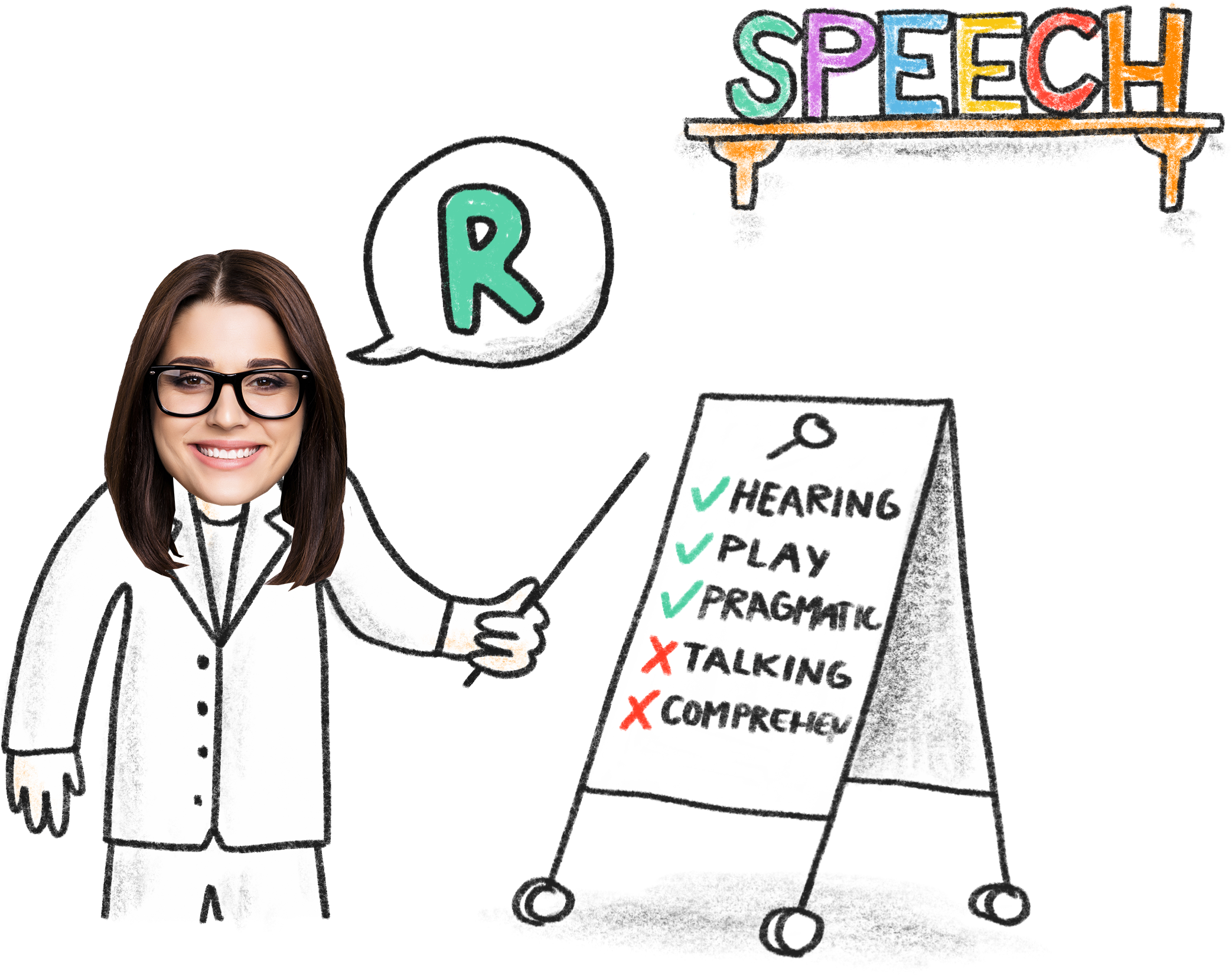R Sound Articulation Therapy: A Guide for Parents
Aug 30, 2024 The R sound is a very unusual sound that has multiple variations. There are as many as 32 different sounding types of the R sound. Yikes!
This article focuses on the R consonant sound and how your child can use our app to practice saying it correctly. Download the app and start your at-home practice today.
As a speech therapist, I can tell you that though the R sound is commonly used in the English language, it is also one of the trickiest. In fact, the R sound is one of the last sounds to be mastered by children. And though it begins to emerge at 3-years-of-age, it often only matures at the ages of 6 or 7.

What is the /R/ Sound?
As already mentioned, the /r/ sound is one of the hardest sounds to master. Children usually master it by the ages of 6-7. Whether a child struggles with the pre-vocalic /r/ (where the R is produced at the beginning of a word) or the vocalic /r/ (when the R sound is produced after a vowel), many speech therapists agree that it can be one of the most challenging sounds to teach. With that being said, there are many tips we can use to help a child practice their /r/ sound.
The key to helping your child correctly say the /r/ sound is to look at three important oral structures used in speech: the lips, the tongue, and the throat.
The Lips
When producing the /r/ sound, we want to make sure to have our lips more in a neutral position or more of a square shape. Some SLPs may also have a child smile.
The Tongue
We can produce the /r/ sound using two tongue positions:
- the retroflex position, where the tip of the tongue is raised or curled at the roof of the mouth;
- the bunched position, where we move our tongue towards the back of our teeth while the tongue tip points a bit down.
The Throat
The upper part of the throat right behind the tongue, also known as the pharynx, must constrict or tighten in order for the correct R sound to be produced. The vocal cords need to vibrate to produce the sound correctly.
Check out the following video:
After watching the video, open our app and practice the words that include the R consonant in them.
Teaching the R Consonant Sound to Your Child
Explain to your child that you are going to practice saying the R sound, like in the word “rabbit.”
Tell your child that when they say the R sound in “rabbit” you’d like to see their lips make an “O” shape. Make sure you show them how if they don’t understand.
Next, to get your child’s tongue in the correct placement position, tell them that their tongue needs to create a hump in the middle of their mouth like a little hill.
This is so that when they say the R sound in “rabbit,” they can pretend that there is a little rabbit hopping over the hill in their mouth to get outside. If there’s no hill, then there’s no correct R sound and the rabbit can’t get out.
Lastly, explain to your child that they need to tighten the back part of their throat so that they can push enough air up into their mouth and along their tongue in order to help the rabbit jump over the hill.
Once they can correctly say the R consonant sound in isolation, follow the articulation error hierarchy which you can read about in this article, or watch in this video.

Some Mo/r/e T/r/icks
The lips
Tell your child to make a “fish face” to help them achieve the correct “O” lip placement. This can become a game to see who can make the funniest face while moving their lips into the correct position.
If this doesn’t work, exaggerate sticking your lips out and telling them to copy you or use a mirror so they can see their own progress. Once they can do this you can refine the positioning of their lips into the correct “O” shape.
Visual cueing and modeling are powerful learning aids that can be used in where you say the correct R consonant sound while your child imitates what your lips are doing. Our app is a wonderful imitation tool, as it develops your child’s articulation skills and other desirable behaviors by promoting learning through watching video demonstrations given by real kids. Download the app for iOS or Android devices.
You can read more about video modeling and imitation by reading the following article: Mirror Neurons, Video Modeling, and Your Child’s Speech.
The Tongue
Physically showing your child where to place their tongue is very effective. Most children who experience difficulty with the R sound are unable to position their tongue correctly because it all happens behind the visual barrier of the front teeth. This can also make it quite frustrating for them.
Once you have reached the word level and are practicing words that start with the R consonant sound, touch the tip of your child’s tongue with your finger or a tongue depressor and tell them that you want them to lift that part up as far as they can without touching the roof of their mouth.
Once you have reached the word level and are practicing words that have the R consonant sound in other places, touch the middle of your child’s tongue with your finger or a tongue depressor and tell them that you want them to lift that part up to create an arch without touching the roof of their mouth.
The Throat
Have your child gargle with water to help them learn how to tighten their throat muscles the way they would when correctly saying the R consonant sound.
You can also draw their attention to this kind of throat tightening by having them drink through a straw and explaining how the muscles work.
When your child says the R sound, place their hand on their neck to feel the vibration made by their vocal cords. If they have trouble creating this vibration, then place their hand on your throat to show them how it’s done. Pretend that the vibration is the “rabbit” hopping. If there’s no vibration, then the “rabbit” isn’t hopping and he can’t get out.
To assist with the voicing and correct articulation of the R consonant sound, tell your child to pretend that they are growling like an angry dog. You can also turn this into game by seeing who can come up with the scariest or funniest growl.
More tips and tricks
- Have your child try and think of their own words that contain the R consonant sound.
- Make up silly phrases or sentences and even imitate appropriate phrases and sentences that you see in more than 1000 bonus video stories anywhere within Speech Blubs 2 or elsewhere.
- Give your child an R consonant word and ask them to make up silly phrases or sentences – this is great language practice!
- Use a mirror within the app at all levels of the hierarchy so that your child can see what they are doing and learn the skill of self-monitoring.
- Put objects or toys that start with or contain a letter R in their name in a bag. Ask your child to draw one by one, and say the name of the object out loud to you.
- When you are outside playing, play a game where you have to name the objects that have the letter R. For example, Road, Bricks, Tree, Branch, Mary-go-round, Water, Stream, River, Car, Truck, Train . . . try to spot as many as you can!
- Play a game called “Rabbit Runs to . . .” Tell your child that they are a rabbit that has to run to a certain place in the house. Each time they reach the place you name, they have to answer the question: “Where did the rabbit run to?” “Rabbit Runs to the Rug.” “Rabbit Runs to the Refrigerator.” “Rabbit Runs to the Door.”
- Make a dictionary of R words. You can use the store free advertisements of products they send to your house. Cut out all the things they sell that have a letter R: broccoli, rice, bread . . . and paste them in a special book. You can write down the names of the objects, and look at them every day to name the objects.

How to Play Articulation Bingo?
- Use the button below to download our Articulation Bingo Board
- Print out the board and give it to your child or cut out the pictures and put them into a bag
- Let your child pick a word from the board/bag
- Find the word in Speech Blubs App and practice it, play with fun filters, and watch educational videos
- Your child is a winner when he practices three pictures in a row (across, down, or horizontally) or the entire board.
Use Speech Blubs app every day for at least 5-10 minutes to achieve the best results.
If you’re worried about your child’s ability to say the R consonant sound or have any other concerns about their pragmatics, comprehension, or talking, use our free screener within the app. Our speech and language pathologist-developed tool will even give you a personalized report with actionable advice with the results.
For more information about the app visit our FAQ section or write to us. Know that you have an ally in Speech Blubs and that our biggest success is seeing your child achieve their greatest potential.
If your child has difficulties with other sounds, here are the articles that can help you with speech therapy, speech exercises, and articulation activities ideas:
- Articulation Therapy: An All-in-One Guide for Parents
- B Sound Articulation Therapy
- H Sound Articulation Therapy
- JJ and CH Sounds Articulation Therapy
- L Sound Articulation Therapy
- Lisp Articulation Therapy
- M Sound Articulation Therapy
- N Sound Articulation Therapy
- NG Sound Articulation Therapy
- S Sound Articulation Therapy
- SH Sound Articulation Therapy
- T and D Sounds Articulation Therapy
- W Sound Articulation Therapy

